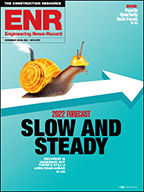He’s often called Autodesk’s thought-leader, a futurist about global construction trends, a big ideas man, probably unfailingly polite and, as of late, a construction science fiction author. (See ENR's Imagining Construction's Future collection.)
Dominic Thasarathar, a directory of strategy at the design and collaboration software provider, would chuckle at the titles, given that the Londoner still thinks of himself as a technology manager from his days with firms such as CH2M Hill and Bechtel. Amid the goings-on at Autodesk University, the annual user conference that attracted over 10,000 users to The Venetian Hotel in Las Vegas in early December, ENR sat down with Thasarathar to talk about some of the buzzwords of technology. Following is an edited transcript as he broke down some of the big trends through the filter of construction.
Q: Cloud computing, remote sensing, 3D printing, augmented reality—and now reality capture has a new buzz around it. What do you make of the latest about reality capture advances?
It’s been much talked about. The way digital modeling has traditionally worked is that somebody ceates a model of something and at some stage, when that model has been analyzed and refined, it’s then turned back into a real world asset.
With reality capture, although laser scanning has been around for so many years, the fidelity of the tools has increased amazingly. So we're now combining that with this notion of capturing reality with digital cemeras, and bringing that into a model that helps you model in the context of the real world. Rather than working from scratch, you’re actually modeling from a real-world environment and then adding context.
The darling of the moment is 3D printing. It, too, is starting to shrink the notion of the number of touches it takes to come up with a physically finished artifact. There are other things that you can do to shrink that process and make it more efficient, such as improving the supply chain, especially with things like better coordination at the design stage to see how costs or schedules are impacted.
We're starting to see this notion of [these processes] becoming far more streamlined from from the real world to the digital one, back into the real one.
Q: But it takes a a lot of computing power to do this...
One of the beauties of the cloud computing trend is that we now have, at least in theory, this notion of unlimited or infinite computing power. For example, if you wanted to do some finite analysis or computational fluid dynamics on your computer, it was really a question of the power of the processor or how many pocessors, using Moore's Law as a defining factor in how we take on these complex computing challenges.
Now, all of a sudden, you could almost sidestep that becuse you can tap into an unimited amount of computing power with this notion of infinite computing (on demand). So this offers the potential to radically transform how you do those complex challenges with those designs because you're no longer restricted to how much [processing] you can afford. There will be great opportunities for coming up with new ways to design.
Q: The internet of things, with IP addresses attached to more devices and buildings, is growing around us. But it's still early yet with the Big Data trend, yes?
The parallel to the internet of things is all the data we're creating. The internet of things is great but how do you monetize it? The question that needs to be answered is: What's in it for me? You could see a potential with owners where they can aggregate in real-time what their energy consumption is, and perhaps go out in real-time and renegotiate a contract based on that demand.
 |
Big data has that potential. It can help us break out of that cycle of learning on the backs of projects, to spot patterns, or address things like material purchasing or how we can use spot-pricing in the way we're procuring materials and services.
Q: We've talked about robots in construction as a trend that's become a controversial topic in construction. What's your take?
Well, certainly in the area of site manufacturing, we're seeing robotics used for pre-fab and in a factory or controlled environment. Certainly we see robots being used in factory environments, or even hazardous environments where there's a threat to human life.
There is almost the central question of automation of construction sites that is: What happens to those workers such as a laborer whose job has been eliminated by robotics?
Arguably, a lot of construction is done by young men who don't have the same opportunities for educaiton as other professions. Where do they go if suddenly that work is taken over?
It's an increasingly realistic question. What happens in other sectors of the economy when you throw a lot of automation at it and, as the technology displaces human roles, what other opportunities will be created?
The onus is on the industry to make these decisions and think of what that means for the future of its workforce.
Q: Back to the present: What has surprised you in terms of a break out trend this year?
A: I'd say it is the increasing role of mandates. Particularly, I'll hold the flag for the UK government and its BIM UK mandate for 2016, for example, that has the potential to really transform the industry in the way that the industry has always talked about wanting to be transformed—changing and reinventing ways of working with the supply chain.
If you look at everything people are doing with BIM tools now: clash detection, or greater collaboration or whatever, you can boil down [its uses to] how productive they are on the project, such as for predictability or outcome—are they going to come in on schedule? On budget? That's what drives the profit.
But now we're seeing users look at what else we can do with BIM besides driving [productivity] on projects. That's the interesting thing I'm starting to hear companies start to talk about.
Dominic Thasarathar is Autodesk’s primary thought-leader for the global construction and natural resources industries. His focus is the strategic role that information and technology can play in helping companies respond to changing markets and achieve competitive advantage. A chartered electrical engineer based in London, he joined Autodesk in 2011 and held previous technology management roles at CH2M Hill, Bechtel and Laing O’Rourke. Thasarathar holds a bachelor’s degree in electrical engineering from Imperial College in London and is a member of The Institution of Engineering and Technology, the British Computer Society and the Energy Institute.


